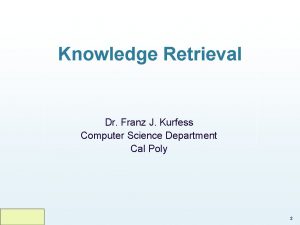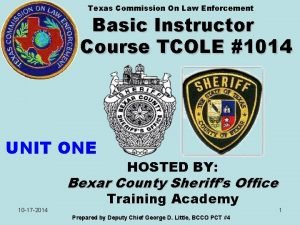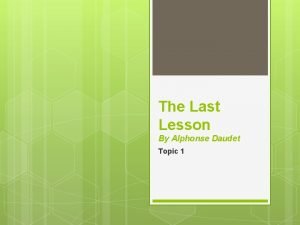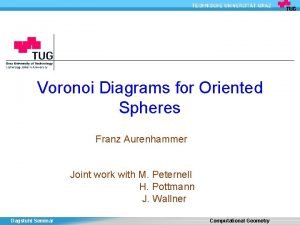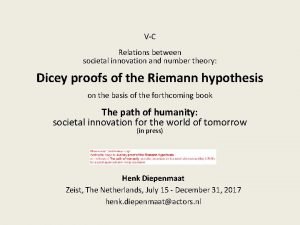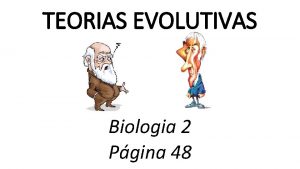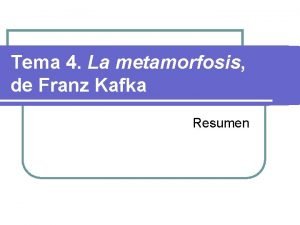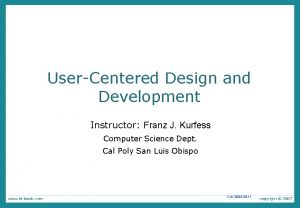UserCentered Design and Development Instructor Franz J Kurfess















































- Slides: 47

User-Centered Design and Development Instructor: Franz J. Kurfess Computer Science Dept. Cal Poly San Luis Obispo FJK 2005

Copyright Notice • These slides are a revised version of the originals provided with the book “Interaction Design” by Jennifer Preece, Yvonne Rogers, and Helen Sharp, Wiley, 2002. • I added some material, made some minor modifications, and created a custom show to select a subset. – Slides added or modified by me are marked with my initials (FJK), unless I forgot it … FJK 2005

484 -W 05 Quarter • The slides I use in class are in the Custom Show “ 484 -W 05”. It is a subset of the whole collection in this file. • Week 4 contains slides from Chapters 6 and 7 of the textbook. • The original slides are a bit of a mess, and I cleaned up various issues – outline view ddidn’t show body text – quite a bit of “manual” formatting (bulleted/numbered lists) FJK 2005

Chapter 7 Needs and Requirements FJK 2005

Chapter Overview • Needs • Requirements • Data Gathering • Data Interpretation and Analysis • Task Description • Task Analysis FJK 2005

Motivation • for user-centered design, it is critical to know the needs of the user • these needs are often described more formally through requirements • since users are not always able to express their needs directly, data gathering techniques are used to collect information • the collected information needs to be interpreted analyzed FJK 2005

Objectives • gain experience identifying user needs and transforming them into requirements • be familiar with various techniques for data gathering, interpretation, and analysis • learn to utilize methods for developing task descriptions FJK 2005

Identifying needs and establishing requirements

Overview • • The importance of requirements Different types of requirements Data gathering Task descriptions: – Scenarios – Use Cases – Essential use cases • Task analysis: HTA

What, how and why? • What: – Two aims: 1. Understand as much as possible about users, task, context 2. Produce a stable set of requirements • How: – – Data gathering activities Data analysis activities Expression as ‘requirements’ All of this is iterative

What, how and why? • Why: – Requirements definition: the stage where failure occurs most commonly – Getting requirements right is crucial

Establishing requirements • • What do users want? What do users ‘need’? – Requirements need clarification, refinement, completion, re-scoping – Input: requirements document (maybe) – Output: stable requirements • Why ‘establish’? – Requirements arise from understanding users’ needs – Requirements can be justified & related to data

Different kinds of requirements • Functional: – What the system should do – Historically the main focus of requirements activities • Non-functional – memory size, response time. . . • Data: – What kinds of data need to be stored? – How will they be stored (e. g. database)?

Different kinds of requirements • Environment or context of use: – physical: dusty? noisy? vibration? light? heat? humidity? …. (e. g. OMS insects, ATM) – social: sharing of files, of displays, in paper, across great distances, work individually, privacy for clients – organisational: hierarchy, IT department’s attitude and remit, user support, communications structure and infrastructure, availability of training

Different kinds of requirements • Users: Who are they? – Characteristics: ability, background, attitude to computers – System use: novice, expert, casual, frequent – Novice: step-by-step (prompted), constrained, clear information – Expert: flexibility, access/power – Frequent: short cuts – Casual/infrequent: clear instructions, e. g. menu paths

Different kinds of requirements • Usability: – learnability – throughput – flexibility – attitude Note that user requirements and usability requirements refer to different things

Exercise: Kinds of requirements What factors (environmental, user, usability) would affect the following systems? • Self-service filling and payment system for a petrol (gas) station • On-board ship data analysis system for geologists searching for oil • Fashion clothes website

Activity: Requirements • Select a task, and try to identify different kinds of requirements – functional/non-functional – data – context – environment – user characteristics – usability FJK 2005

Activity: Task Suggestions • video downloading application • voice interaction with household devices • touch-screen ordering system for cafeteria ordering • navigation system for motorcycles FJK 2005

Data Gathering Techniques • Questionnaires • Interviews • Workshops and Focus Groups • Naturalistic Observation • Studying Documentation

Questionnaires • A series of questions designed to elicit specific information – questions may require different kinds of answers: • simple YES/NO • choice of pre-supplied answers; comment • Often used in conjunction with other techniques • Can give quantitative or qualitative data • Good for answering specific questions from a large, dispersed group of people

Interviews • Forum for talking to people • Structured, unstructured or semistructured • Props can be used in interviews – e. g. sample scenarios of use, prototypes • Good for exploring issues • But are time consuming and may be infeasible to visit everyone

Workshops and Focus Groups • Group interviews • Good at gaining a consensus view and/or highlighting areas of conflict

Observation • Spend time with stakeholders – in their day-to-day tasks, observing work as it happens • Gain insights into stakeholders’ tasks • Good for understanding the nature and context of the tasks • Requires time and commitment from a member of the design team • Can result in a huge amount of data • Ethnography is one form

Studying Documentation • Procedures and rules are often written down in manuals • Good source of data about – steps involved in an activity – regulations governing a task • Not to be used in isolation • Good for understanding legislation, and getting background information • No stakeholder time – a limiting factor on the other techniques

Choosing between techniques • Data gathering techniques differ in two ways: – Amount of time, level of detail and associated with the findings – Knowledge the analyst requires risk • Also affected by the kind of task to be studied: – Sequential steps or overlapping series of subtasks? – High or low, complex or simple information? – Task for a layman or a skilled practitioner?

Activity: Data Gathering Techniques • for each of the following data gathering techniques, try to find situations or tasks where it is particularly appropriate: – questionnaires – interviews – workshops and focus groups – naturalistic observation – studying documentation FJK 2005

Data Gathering Problems (1) • Identifying and involving stakeholders – users, managers, developers, customer reps? , union reps? , shareholders? • Involving stakeholders – workshops, interviews, workplace studies, coopt stakeholders onto the development team • ‘Real’ users, not managers – traditionally a problem in software engineering, but better now

Data Gathering Problems (2) • Requirements management – version control, ownership • Communication between parties – within development team – with customer/user – between users… different parts of an organisation use different terminology • Domain knowledge distributed and implicit: – difficult to dig up and understand – knowledge articulation: how do you walk? • Availability of key people

Data Gathering Problems (3) • Political problems within the organisation • Dominance of certain stakeholders • Economic and business environment changes • Balancing functional and usability demands

Some basic guidelines (1) • Focus on identifying the stakeholders’ needs • Involve all the stakeholder groups • Involve more than one representative from each stakeholder group • Use a combination of data gathering techniques

Some basic guidelines (2) • Support the process with props – prototypes – task descriptions • Run a pilot session • You will need to compromise – on the data you collect – the analysis to be done, – but before you can make sensible compromises, you need to know what you’d really like • Consider carefully how to record the data

Data interpretation and analysis • Start soon after the data gathering session • Initial interpretation before deeper analysis • Different approaches emphasize different elements – class diagrams for object-oriented systems – entity-relationship diagrams for data intensive systems

Task descriptions • Scenarios – an informal narrative story, simple, ‘natural’, personal, not generalizable • Use cases – assume interaction with a system – assume detailed understanding of the interaction • Essential use cases – abstract away from the details – does not have the same assumptions as use cases

Scenario for shared calendar “The user types in all the names of the meeting participants together with some constraints such as the length of the meeting, roughly when the meeting needs to take place, and possibly where it needs to take place. The system then checks against the individuals’ calendars and the central departmental calendar and presents the user with a series of dates on which everyone is free all at the same time. Then the meeting could be confirmed and written into people’s calendars. Some people, though, will want to be asked before the calendar entry is made. Perhaps the system could email them automatically and ask that it be confirmed before it is written in. ”

Use case for shared calendar • • • The user chooses the option to arrange a meeting. The system prompts user for the names of attendees. The user types in a list of names. The system checks that the list is valid. The system prompts the user for meeting constraints. The user types in meeting constraints. The system searches the calendars for a date that satisfies the constraints. The system displays a list of potential dates. 9. The user chooses one of the dates. 10. The system writes the meeting into the calendar. 11. The system emails all the meeting participants informing them of them appointment

Alternative courses for shared calendar 5. If the list of people is invalid, 5. 1 The system displays an error message. 5. 2 The system returns to step 2. 8. If no potential dates are found, 8. 1 The system displays a suitable message. 8. 2 The system returns to step 5.

Activity: Task Descriptions • use the following methods to develop task descriptions for the topic you chose in Assignment 2 – scenarios – use cases – essential use cases • in a team, you can split up and use the methods in parallel – ideally, there should be a significant overlap – probably also differences • different methods used • different people involved FJK 2005

Example use case diagram for shared calendar

Example essential use case for shared calendar arrange. Meeting USER INTENTION arrange a meeting identify meeting attendees & constraints choose preferred date SYSTEM RESPONSIBILITY request meeting attendees & constraints search calendars for suitable dates suggest potential dates book meeting

Task analysis • Task descriptions are often used to envision new systems or devices • Task analysis is used mainly to investigate an existing situation • It is important not to focus on superficial activities What are people trying to achieve? Why are they trying to achieve it? How are they going about it? • Many techniques, the most popular is Hierarchical Task Analysis (HTA)

Hierarchical Task Analysis • Involves breaking a task down – into subtasks, then sub-tasks and so on. – These are grouped as plans which specify how the tasks might be performed in practice • focuses on physical and observable actions – includes looking at actions not related to software or an interaction device • Start with a user goal – which is examined and the main tasks for achieving it are identified

Example Hierarchical Task Analysis 0. In order to borrow a book from the library 1. go to the library 2. find the required book 2. 1 access library catalogue 2. 2 access the search screen 2. 3 enter search criteria 2. 4 identify required book 2. 5 note location 3. go to correct shelf and retrieve book 4. take book to checkout counter

Example Hierarchical Task Analysis (plans) plan 0: do 1 -3 -4. If book isn’t on the shelf expected, do 2 -3 -4. plan 2: do 2. 1 -2. 4 -2. 5. If book not identified do 2. 2 -2. 3 -2. 4.

Example Hierarchical Task Analysis (graphical) Borrow a book from the library 0 plan 0: do 1 -3 -4. If book isn’t on the shelf expected, do 2 -3 -4. go to the library 1 find required book 2 retrieve book from shelf 3 take book to counter 4 plan 2: do 2. 1 -2. 4 -2. 5. If book not identified from information available, do 2. 2 -2. 3 -2. 4 -2. 5 access catalog 2. 1 access search screen 2. 2 enter search criteria 2. 3 identify required 2. 4 book note location 2. 5

Activity: Task Analysis • apply hierarchical task analysis (HTA) to the task you selected for Assignment 2 FJK 2005

Summary • Getting requirements right is crucial • There are different kinds of requirements – each is significant for interaction design • The most commonly-used techniques for data gathering are – questionnaires, interviews, focus groups and workshops, naturalistic observation, studying documentation • Scenarios, use cases and essential use cases can be used to articulate existing and envisioned work practices. • Task analysis techniques such as HTA help to investigate existing systems and practices
 Franz kurfess
Franz kurfess Franz kurfess
Franz kurfess Stephen kurfess
Stephen kurfess Ned kurfess
Ned kurfess Ac 61-65
Ac 61-65 Virtual instructor art
Virtual instructor art Lo más importante en la tipología de los participantes
Lo más importante en la tipología de los participantes Tcole instructor course
Tcole instructor course Basic instructor course texas
Basic instructor course texas Basic instructor course texas
Basic instructor course texas Pepperball training manual
Pepperball training manual Not only the students but also their instructor
Not only the students but also their instructor Instructor vs teacher
Instructor vs teacher Cisco certified instructor
Cisco certified instructor Mptc firearms
Mptc firearms Basic instructor course texas
Basic instructor course texas Basic instructor course texas
Basic instructor course texas Nfpa 1403
Nfpa 1403 Human factors instructor
Human factors instructor Instructor operating station
Instructor operating station Catia instructor
Catia instructor Instructor
Instructor Tcole 1014 basic instructor course
Tcole 1014 basic instructor course Usmc jrotc vacancies
Usmc jrotc vacancies Nrp instructor toolkit
Nrp instructor toolkit Utp cable
Utp cable Cbrf registry wisconsin
Cbrf registry wisconsin Nra certified instructor logo
Nra certified instructor logo Naismith was an instructor of
Naismith was an instructor of Please clean your room
Please clean your room Tcole advanced instructor course
Tcole advanced instructor course Tcole advanced instructor course
Tcole advanced instructor course Jrotc marksmanship instructor course online
Jrotc marksmanship instructor course online エイムズの部屋
エイムズの部屋 Acr medical term
Acr medical term Basic instructor course #1014
Basic instructor course #1014 Basic instructor course tcole
Basic instructor course tcole Delmar cengage learning instructor resources
Delmar cengage learning instructor resources Instructor office hours
Instructor office hours What changes did the order from berlin cause in the school
What changes did the order from berlin cause in the school Frederick william franz
Frederick william franz Franz aurenhammer
Franz aurenhammer (770) 905-2309
(770) 905-2309 Cuantos capitulos tiene un grito desesperado
Cuantos capitulos tiene un grito desesperado Franz josef och
Franz josef och Haydn mappa concettuale
Haydn mappa concettuale Embriologia comparada exemplos
Embriologia comparada exemplos Estructura de la metamorfosis
Estructura de la metamorfosis



